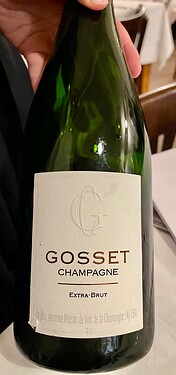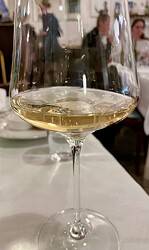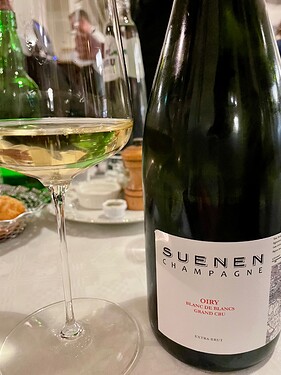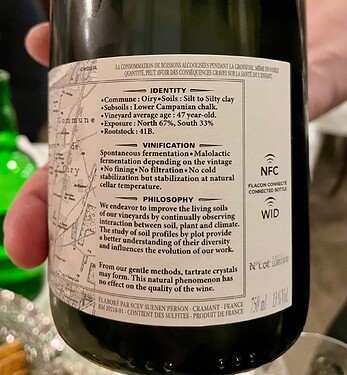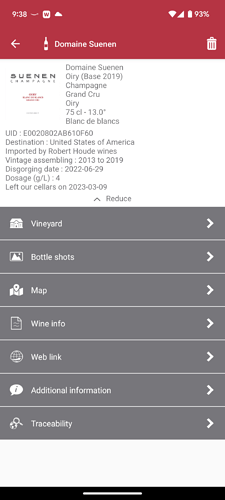Ah. So it goes ![]()
Wine Searcher Pro list 8 suppliers in the US (albeit all in the north-east) with prices ranging from US$126 to US$174.99.
Extracted from a thread just posted re a recent fabulous dinner in Amsterdam: A fabulous dinner in Amsterdam with 2 local wine guys with champagne and wines from 1934, 1966, a white and red Burgundy and a Barolo
When I was first seated at the table, I was poured a glass of champagne:
NV GOSSET EXTRA BRUT- i immediately thought of one of my blind tasting group members in Santa Barbara who loves acidity in wines as this was very acidic while sporting a yellow gold color and a fruit profile of primarily pear and bruised green apple from the nose on through; it had a quite noticeable amount of weight and body and was very yeasty; when I looked this release up, I discovered it was made especially for the restaurant trade and is a blend of 45% Pinot Noir, 32% Chardonnay and 23% Pinot Meunier, sees no ML, spends 36 months on the lees and is dosed at 5 gpl.
Three of us opted for a champagne off the restaurant wine list that was highly recommended by the Somm, Eelke Leeuwerink, who knew and coordinated this in advance with our 3rd member, frequented out table, was very knowledgeable and performed superb wine service.
He informed us, the producer is one of those under the radar, up and coming houses that has been crafting some consistently fabulous champagnes of late, is now becoming much more recognized and like most others, the prices will be going up. Here is some info from the Domaine’s website:
“Founded by Aurélien Suenen, representing the 4th generation of a line of winemakers, Domaine is renowned for its Champagnes of exceptional quality, reflecting the unique terroir of Côte des blancs.
The family history dates back to Edmond, who began cultivating vines at Cramant in the early 20th century. His son, Georges, consolidated the family wine business, and it was under the guidance of his grandson, Aurélien, that Domaine underwent a significant transformation.
Aurélien, a passionate and visionary winemaker, took the reins of Domaine at the beginning of the 21st century. Driven by the desire to produce Champagnes of exceptional elegance, he has combined the traditional know-how inherited from his family with modern, environmentally-friendly viticultural practices.
The Domaine covers around 8 hectares, mainly located in the prestigious Côte des blancs, renowned for its chalky soils and climate conducive to white grape varieties. The vines, mainly planted with Chardonnay, benefit from ideal exposure, favoring optimal ripening of the grapes.
The philosophy is rooted in the principle of terroir purity. Yields are kept low to ensure optimum concentration of aromas, and vinification is carried out by plot to capture the subtle nuances of each lieu-dit.
Aurélien Suenen favors non-interventionist winemaking methods, allowing the terroir to express itself fully in the wines. Fermentations are often carried out with indigenous yeasts, adding an extra dimension to the aromatic complexity.”
Our bottle was indeed superlative:
NV SUENEN CHAMPAGNE BLANC de BLANC GRAND CRU ORY- this was aged on the lees from 24-36 months and dosed at 4 gpl; following its light yellow color came aromas of fresh citrus fruit with a hint of honey which continued on once tasted to be more specifically lemon and grapefruit; it was clean, crisp and wonderful and seemed to gain richness while rounding out; I loved the bright acidity and the palate cleansing effect it had as well; we kept returning to it over the course of the evening and it just got better and better and I left with this being the last taste to enjoy on the walk back.
Proost,
Blake
Which base vintage on that Suenen, Blake? (I agree it’s a great wine, but the price increase does give me pause now…)
Wish I knew. None on the label, but the latest release is supposedly 2019 and I’m assuming that’s it but not sure.
Hmmmmm, weird. Suenen at least used to put base vintage on his labels … bummer about the apparent change.
My bottles of 2019 base all have NFC embedded in the label, while my 2017 base do not. Not sure when Suenen made the switch, but the amount of detail provided by the WID ap is quite nice.
Very cool. I don’t recall my prior bottles having NFC.
NV Egly-Ouriet Champagne Grand Cru Brut Rosé - France, Champagne, Champagne Grand Cru (11/14/2024)
– popped and poured –
– tasted non-blind over 2 hrs in a restaurant setting –
– Disgorged: Sept. 2022 –
– Dosage: 2 g/L –
– 2017 base vintage –
– 50 mos. on lees –
NOSE: lightly red-fruited; toasty and just ever-so-slightly autolytic in nature.
BODY: striking raw salmon color; fine, persistent bead; light body.
TASTE: light red berries; toasty; medium+ acidity; broad presence; quite good, but I was honestly a bit disappointed by this — not because it wasn’t good (it is), but rather because it didn’t raise my eyebrows the way most other bottles of Egly have. Around the same price, I prefer Bollinger’s LGA rose. Will buy again, but it will have to be a different base vintage.
Brian,
I prefer my rosés younger and fresher compared to non-rosé champagnes, but I’ve noticed this particular cuvée really benefits from some bottle age. I wouldn’t judge it based on a bottle that’s only two years post-disgorgement, especially with the added challenge of a 2017 base. That said, I also really enjoy the Bollinger LGA Rosé, though I’ve only had it once.
Cheers,
Warren
So, NFC appears on the right of the back label and thus is 2019 base- thanks for confirming.
I’m not sure that is 2019. I suppose it could be 2018 or 2020; I’m not sure when Suenen made the change to their labels, or whether the 2020 base is out yet (I’ve had the 2019 base in my cellar for about a year now).
When you scan the Suenen with the WID app, does the wine information shown give the base vintage?
Yes, it shows base vintage, disgorgement date, dosage and some other info. I think it also gives access to a PDF that contains a lot of info on the vineyard, growing season and vinification.
Thanks for this, Warren. As my “luck” would have it, I purchased two bottles of the '17 base, so I will be trying it again, even if I don’t buy it again. Your comments about ageing this wine reflect my experiences with Vilmart’s Cuvee Rubis – multiple times I’ve found it somewhat unexciting in its youth, but with five years or so of bottle age it transforms into something far more impressive. It will be great if that’s what I see with this Egly, too. Cheers!
This is new to me. I did get the app and try to scan the code off the photo, but was unsuccessful. So, until I can actually verify the base year, I stand corrected and am not sure. Any suggestions?
There’s a chip in the label. You need to be close to scan it. Each bottle has a different chip. Selosse were the first to use it I think 3 years ago.
Francis has told me that he prefers the rose with at least 4 years of age.
Which other Egly bottlings have raised your eyebrows?
Bisseuil
Tradition/Grand Cru
Vrigny (which is kind of a big deal, considering I typically dislike PM)
and even the Premices, for the price. (excuse any spelling mistakes – I wrote all of the above from memory)
I haven’t had any of the more expensive bottlings, and likely never will on my own dime; I do have some VP yet to arrive, and that’s about where I will top-out, pricing wise. All of the above were consumed within the past year. Didn’t note base on the Bisseuil. Tradition/Grand Cru was 2017 base. Vrigny was 2018 base. And don’t know base for the Premices.
